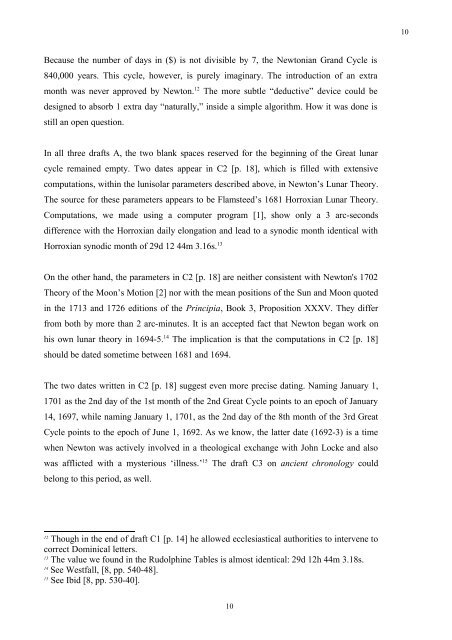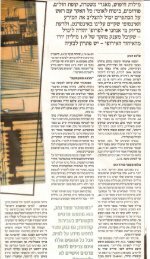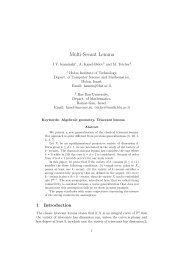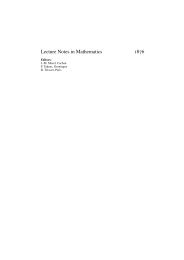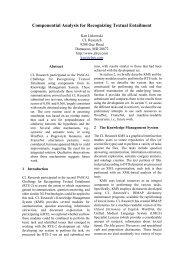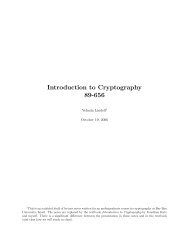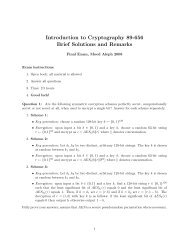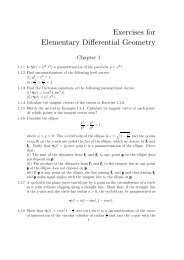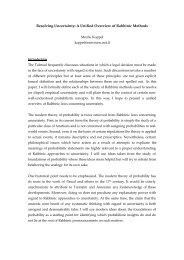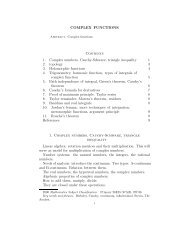Reform of the Julian Calendar as Envisioned by Isaac Newton
Reform of the Julian Calendar as Envisioned by Isaac Newton
Reform of the Julian Calendar as Envisioned by Isaac Newton
You also want an ePaper? Increase the reach of your titles
YUMPU automatically turns print PDFs into web optimized ePapers that Google loves.
10<br />
Because <strong>the</strong> number <strong>of</strong> days in ($) is not divisible <strong>by</strong> 7, <strong>the</strong> <strong>Newton</strong>ian Grand Cycle is<br />
840,000 years. This cycle, however, is purely imaginary. The introduction <strong>of</strong> an extra<br />
month w<strong>as</strong> never approved <strong>by</strong> <strong>Newton</strong>. 12 The more subtle “deductive” device could be<br />
designed to absorb 1 extra day “naturally,” inside a simple algorithm. How it w<strong>as</strong> done is<br />
still an open question.<br />
In all three drafts A, <strong>the</strong> two blank spaces reserved for <strong>the</strong> beginning <strong>of</strong> <strong>the</strong> Great lunar<br />
cycle remained empty. Two dates appear in C2 [p. 18], which is filled with extensive<br />
computations, within <strong>the</strong> lunisolar parameters described above, in <strong>Newton</strong>’s Lunar Theory.<br />
The source for <strong>the</strong>se parameters appears to be Flamsteed’s 1681 Horroxian Lunar Theory.<br />
Computations, we made using a computer program [1], show only a 3 arc-seconds<br />
difference with <strong>the</strong> Horroxian daily elongation and lead to a synodic month identical with<br />
Horroxian synodic month <strong>of</strong> 29d 12 44m 3.16s. 13<br />
On <strong>the</strong> o<strong>the</strong>r hand, <strong>the</strong> parameters in C2 [p. 18] are nei<strong>the</strong>r consistent with <strong>Newton</strong>'s 1702<br />
Theory <strong>of</strong> <strong>the</strong> Moon’s Motion [2] nor with <strong>the</strong> mean positions <strong>of</strong> <strong>the</strong> Sun and Moon quoted<br />
in <strong>the</strong> 1713 and 1726 editions <strong>of</strong> <strong>the</strong> Principia, Book 3, Proposition XXXV. They differ<br />
from both <strong>by</strong> more than 2 arc-minutes. It is an accepted fact that <strong>Newton</strong> began work on<br />
his own lunar <strong>the</strong>ory in 1694-5. 14 The implication is that <strong>the</strong> computations in C2 [p. 18]<br />
should be dated sometime between 1681 and 1694.<br />
The two dates written in C2 [p. 18] suggest even more precise dating. Naming January 1,<br />
1701 <strong>as</strong> <strong>the</strong> 2nd day <strong>of</strong> <strong>the</strong> 1st month <strong>of</strong> <strong>the</strong> 2nd Great Cycle points to an epoch <strong>of</strong> January<br />
14, 1697, while naming January 1, 1701, <strong>as</strong> <strong>the</strong> 2nd day <strong>of</strong> <strong>the</strong> 8th month <strong>of</strong> <strong>the</strong> 3rd Great<br />
Cycle points to <strong>the</strong> epoch <strong>of</strong> June 1, 1692. As we know, <strong>the</strong> latter date (1692-3) is a time<br />
when <strong>Newton</strong> w<strong>as</strong> actively involved in a <strong>the</strong>ological exchange with John Locke and also<br />
w<strong>as</strong> afflicted with a mysterious ‘illness.’ 15 The draft C3 on ancient chronology could<br />
belong to this period, <strong>as</strong> well.<br />
12<br />
Though in <strong>the</strong> end <strong>of</strong> draft C1 [p. 14] he allowed ecclesi<strong>as</strong>tical authorities to intervene to<br />
correct Dominical letters.<br />
13<br />
The value we found in <strong>the</strong> Rudolphine Tables is almost identical: 29d 12h 44m 3.18s.<br />
14<br />
See Westfall, [8, pp. 540-48].<br />
15<br />
See Ibid [8, pp. 530-40].<br />
10


